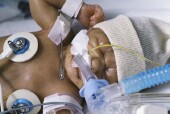
MONDAY, Sept. 8, 2014 (HealthDay News) — Fewer children are developing infections related to their care in the hospital than they were seven years ago, according to a new study.
The rate of bloodstream infections and pneumonia associated with critically ill children’s health care in intensive care units fell by more than 50 percent between 2007 and 2012, researchers found.
“We’re recognizing that there are things that happen at hospitals that are preventable and there are things we can do to make being in the hospital safer, including for our most vulnerable patients,” said lead researcher Dr. Stephen Patrick, assistant professor of pediatrics and health policy at Vanderbilt University in Nashville.
“These are preventable complications that can be deadly or have life-long consequences, and I think this is a nice success story of providers getting together and saying the status quo is not acceptable,” Patrick said.
According to background information from the study, any device that must enter a person’s body carries the risk of introducing an infection. Ventilators can lead to pneumonia, and catheters sometimes cause urinary tract infections. Central lines are long, flexible tubes that lead directly into a blood vessel and remain there during a person’s care. Although central lines are necessary for delivering medications, fluids and nutrition, they can sometimes cause bloodstream infections.
A nationwide push to reduce these hospital-acquired infections has been under way for a number of years in the United States. This has included a special focus on children spearheaded by national children’s hospital organizations and individual neonatal intensive care units (NICUs), Patrick said.
“The biggest contributor to overcoming these infections is a culture change,” Patrick said. “When I walk into the NICU, I take off all my rings, I don’t wear a tie, and I don’t wear a white coat. It’s an entire mindset of what can I do to prevent infection in this patient, and that’s a real culture shift that’s happened in the last several years.”
Patrick’s team analyzed the data on hospital-acquired infections among critically ill children at 173 neonatal intensive care units and 64 pediatric intensive care units throughout the United States. They focused specifically on rates of central line-associated bloodstream infections, ventilator-associated pneumonia, and catheter-associated urinary tract infections from 2007 through 2012. The researchers measured the number of infections per 1,000 days’ use of that medical device among all patients in that intensive care unit.
Bloodstream infections from central lines in neonatal intensive care units decreased from about 4.9 infections to about 1.5 infections out of every 1,000 days’ use of a central line. In pediatric intensive care units, bloodstream infections from central lines also decreased, from 4.7 infections to 1 infection per 1,000 days. Urinary tract infections associated with catheters did not decline. But rates of pneumonia linked to ventilators did, from 1.6 cases to 0.6 cases per 1,000 days of ventilator use in neonatal intensive care units and 1.9 cases to 0.7 cases per 1,000 days in pediatric intensive care units, the study found.
The smallest babies were at highest risk for infection. Newborns weighing less than 3.3 pounds at birth were more than twice as likely to develop a central line-associated bloodstream infection and more than three times more likely to develop ventilator-associated pneumonia, compared to newborns with birth weights above 5.5 pounds.
The study findings were published online Sept. 8 in the journal Pediatrics.
Infectious disease expert Dr. Eli Perencevich, a professor of internal medicine and epidemiology at the University of Iowa Carver College of Medicine, agreed that a cultural shift has played the biggest role in reducing infections, but said a second reason is having good research.
“One of the unique things about infection control is that we have data on how to cut infection risk,” Perencevich said. “We’ve developed antimicrobial catheters and dressings, and we know if you insert the catheter properly and if you take care of the ventilator appropriately, you can reduce infections.”
Parents can also help reduce their child’s infection risk, Patrick said, especially by washing their hands regularly and encouraging visitors to wash their hands.
“Things that we know work are hand washing and being there as an advocate for your child’s care,” Patrick said. “Being an active voice for your child is a strong way to be part of the team that’s providing care to your kid. Parents can also feel empowered to ask their health-care providers to wash their hands as well.”
Despite these decreases in infections, challenges remain, Perencevich said.
“The biggest challenge is that not everything is preventable,” he said. “We know pretty well how to prevent most infections, but with current technology, we can’t get infections to zero because that would mean never putting in a central line or intubating a baby, and that’s not acceptable.”
Perencevich said it’s therefore important to continue investing in research related to preventing health-care associated infections.
“If we don’t keep pushing forward, rates could increase or we won’t continue to move forward,” Perencevich said. “I wouldn’t want these lower rates to be a reason to take our foot off the gas, so to speak.”
More information
The National Patient Safety Foundation has more about preventing hospital infections.
Copyright © 2025 HealthDay. All rights reserved.

